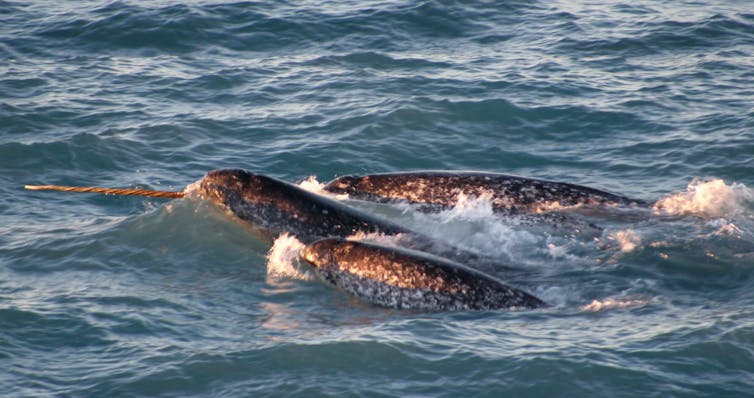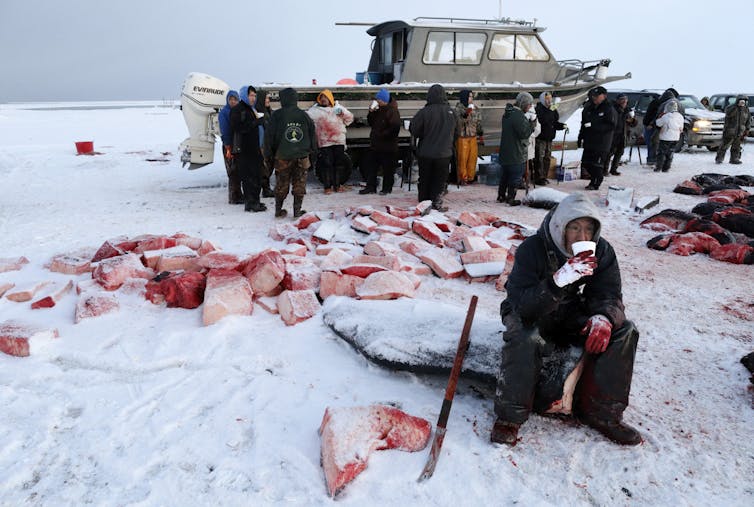
Bowhead whales are the longest-lived mammals on Earth, some of which can live for hundreds of years. Additionally, Inuit hunters have witnessed these whales breaking off the ice half a meter thick – ice strong enough to a fully loaded semi truck.
The habitat of narwhal whales overlaps with that of bowhead whales in the Arctic. Narwhals took center stage Northern European mythology about the legendary unicorn because of their distinctive tusk.
However, despite their iconic status in the eyes of many, both beautiful creatures have faced centuries of violent persecution at the hands of human commercial whalers. Bowhead whales in particular were prized for their blubber, oil, bones and filter feeding system by 1540 to the 20th century – a period of almost 400 years.
A reminder of this exploitation was found in 2007, when there was a bowhead whale in Alaska Fragments of a harpoon were found settles in his body. Originally hurled in the late 1800s, this remnant of Massachusetts whalers is representative of the long-lasting effects of commercial whaling on individual animals and their populations.
As these species recover from the impacts of commercial whaling, they now face a new challenge: climate change. The Arctic is about to warm up four times faster than the global averagecausing profound changes in the region’s ecosystem. Species that have adapted to living in these extreme conditions, such as polar bears, Arctic seabirds And Arctic fishWe must all adapt to climate change now or they will perish.
Read more:
The Canadian Arctic shows how understanding the effects of climate change requires a long-term view
Adapt or die
One way organisms can adapt to climate change is through adaptation. Adaptation is one concept with a long history in biology and one central theme: organisms must adapt to their environment, often through evolution.
Adaptation largely depends on the genetic variation present in a populationas variation is the raw material for evolutionary change. However, if you remove large numbers of individuals from a population, whether through hunting, habitat loss, or other factors, then yes remove genetic variation. In this way, hunting and habitat loss directly hinder species adaptation.
 A group of narwhals surface in northern Canada.
A group of narwhals surface in northern Canada.
THE CANADIAN PRESS/AP Photo/Kristin Laidre, NOAA
Has commercial whaling affected genetic variation in Arctic whales? That was the question we wanted to answer for both bowhead whales and narwhals. Our goal was to understand how the historical exploitation of these two species may influence their ability to respond to climate change in the future.
This work was a collaborative effort. Our team from the University of Manitoba worked with Hunters for the Inuit’s livelihoodresearchers from the Assiniboine Park Zoo And Fisheries and Oceans Canada. Together we sought to unravel the genetic legacy left by centuries of commercial whaling and its implications for the resilience of these iconic Arctic species.
Striking consequences
Focusing on whales in the eastern Canadian Arcticwe looked for changes in effective population size – the number of individuals contributing to a population – across thousands of generations for each species. The results were immediately striking.
We observed a sharp decline in the effective population size of bowhead whales concurrent with commercial whaling, a clear indication of the impact this industry was having on their genetic diversity. Narwhals, on the other hand, showed no similar decline.
These patterns are consistent with historical records showing that commercial whalers primarily targeted bowhead whales. Surprisingly, the narwhals in our study had much less genetic variation than the bowhead whales. We thought that bowhead whales, which have undergone more intensive exploitation, would have lower genetic diversity than narwhals today, if both species started out with a similar level of variation.
 A butcher takes a break while butchering a whale in a field near Barrow, Alaska in October 2014.
A butcher takes a break while butchering a whale in a field near Barrow, Alaska in October 2014.
(AP Photo/Gregory Bull)
It turns out that not every species started out at a similar level of genetic variation.
About 2.5 million years agoBoth species showed a decrease in effective population size, which was more pronounced in the narwhal. It is possible that this decline was caused by an ice age that may have been caused by a “nearby” supernova explosion that damaged the earth ozone layer.
Whatever the cause, our research shows that narwhals in our study area have much less genetic variation than bowhead whales today.
An uncertain prospect
What does this mean for climate change adaptation? Unfortunately, the forecasts are worrying.
Narwhals have less genetic variation to work with, but bowhead whales don’t fare as well either. Commercial whaling has increased the effective population size of bowhead whales more than tenfold, putting them at risk of further reductions in genetic variation in the future. Despite the recovery in numbers, bowhead whales may be reaching a plateau well below pre-whaling estimates.
Urgent conservation measures can preserve the remaining genetic variation, allowing bowhead whales to partially recover and hopefully weather the worst impacts of climate change. Although Canadian narwhals may not be at immediate risk in the Arctic due to their low genetic variation, they will still require conservation attention due to their limited ability to adapt to changing environments.
Read more:
Whales are recovering from near extinction, but industrial fishing around Antarctica competes for their only food source
It takes much longer to build up genetic variation than it does to lose it. Just as a 19th century harpoon was found embedded in a bowhead whale in 2007, the legacy of commercial whaling in the past has a profound influence on the genetics of bowhead whale populations in the present. This history will continue suppressed genetic variation for millenniawhich poses a long-term challenge for the conservation of this species.
Luckily both narwhals And Greenland whales are subject to federal protection in Canada. Intense at the same time Commercial whaling has largely stopped. That being said, the The consequences of climate change are increasing at an increasingly rapid paceespecially in the Arctic.
The bowhead whale and narwhal demonstrate how past events, human actions, current challenges and future threats intersect to shape biodiversity in the Arctic. The lessons we have learned about connecting the past with the present in the narwhal and the Greenland Sea can and should contribute to efforts to protect the biodiversity of all species as they try to adapt to a changing climate.